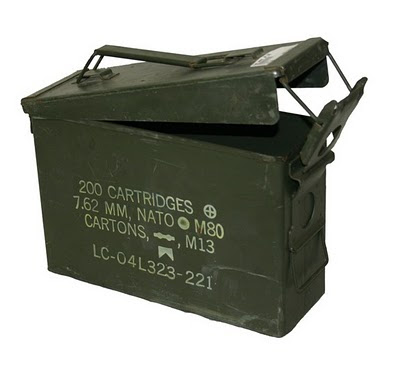Praxis: Keep your powder dry (and your primers, and your loaded ammo)

American Handgunner ran an article back in its November/December 2012 issue, entitled "Flooded? Your Ammo Is Going To Lose . . ." You can find it here and here.
The article concludes:
The entire mess can be avoided by storing your ammunition and components in waterproof cans or containers. Viryually any surplus military ammunition cans have a waterproof seal on the lid. There are also very good commercial waterproof plastic ammunition cans available. Make sure what you buy has a rubber seal in the lid. Anything stored in these cans, with a small packet of desiccant, will survive a substantial submersion for several days.
GI ammo cans are getting scarce these days, and the prices have gone up considerably. An M19A1 "thirty cal" can, which used to be readily available for $5.00 each are now double that, or more. An M2A1 "fifty cal" can which could be had for $8.00 is now (at the last Birmingham AGCA show) twenty bucks each. Expensive? Yes. But compared to what? These cans provide an indispensable function -- they keep you ammo and components dry. What would be the cost if your ammo or components (which are highly hygroscopic on their best day) are ruined because of preventable exposure to moisture?
Back in 2009, Rifleman's Journal published this excellent article, "IT DON’T GO BANG: Fires, Hangfires, Misfires and Short Order Cooks in Jersey." An excerpt:
Primer Storage
All the directions say to keep them in a “cool dry place”. One primer engineer I know who is a shooter gets a bit more serious than that. I will pass on to you his instructions/recommendations; I follow them. Buy primers by the case of 5000 and try to get them right out of the factory. As soon as I get them they go into a 20MM ammo can (which will hold four or five cases of primers). As I need primers I will go and quickly open the 20MM can and remove 1000 and close the can as soon as possible. These 1000 go into a 30 cal ammo can until used. I only open this can in the lowest humidity conditions possible: winter or an air conditioned area in the summer. I remove 100 or 200 primers and place these in a plastic bag with a closure type arrangement. I remove the primers, seat them, charge the cases, seat the bullets in as short a time span as is practical. He even recommends if you are going to be hunting etc coat the ends with clear nail polish wiping off the excess on a paper towel will leave the polish in place around the circumference of the seated primer. He then places these in plastic boxes and they go back into another GI ammo can for storage until he goes to the range. [Storing primers in a sealed container like an ammo can is contrary to SAAMI recommendations and is potentially quite dangerous -GAS-]
Humidity is the worst enemy followed by lubricant contamination. I am aware of one lot of government .308 Match ammo that malfunction investigation showed had oil contamination from a over lubricated machine on the loading line. Another lot was discarded when it was found to have oil in the primer mix that dropped in from a mixer blending the ingredients.
In the government (military) when misfires occur with a ammunition lot or anything else out of the ordinary a Quality Deficiency Report (QDR) is supposed to be filled out and sent to Picatinny Arsenal for malfunction investigation. I was told by my Branch Chief that the first thing done is to query the world-wide ammo control point as to how much of that ammo lot remains in the system. When the report comes back that there is, say, three hundred to four hundred thousand of that lot, they follow this with a World Wide Destruct Advisory to destroy all ammunition of that lot number remaining in any depot. Regardless of whether it is bad or not. It is cheaper to destroy that to investigate!
You may have noted that with the exception of match ammo, you have never seen government ammo newer than three years old being used. This is because all the new ammo goes into War Reserves in the ammo storage depots around the world and the oldest ammo is then removed and sent to the troops which is generally three years for some calibers and maybe forty years for others. Remember we went all through WW2, Korea and Viet Nam with WW2 50 caliber ammunition because so much had been warehoused. Not to worry here folks, government ammo stored in its original unopened cans has a MINIMUM expected life of 125 years. The trick is to never open the can until it's time to use it. Once opened and exposed to the air, the shelf life drops remarkably quickly.
Now, regarding storing primers in an air-tight ammo can, I made a call to a long-time friend who has been doing just that for the past thirty years and he states that he has never noticed a problem. Statistical fluke? Perhaps. As one poster over at the Accurate Shooter forum noted:
I hear you Jon. I've had the same experience: NO duds, luck? I am mostly concerned with consistent performance. I've heard in the past that they're almost impossible to deactivate although when I want to discard a live one I soak it with motor oil.
However I don't let my own or any others experience trump demonstrable, logical advice. I've heard too many folks justify unsafe and/or damaging actions with "I've been doing this for XX years without a problem". I don't believe that applies in this case. It's just a general observation.
I also notice that manufacturers make no effort to protectively package bricks of primers knowing they will sit on shelves for an indeterminate length of time in all manner of environment. Most cookies are better protected from humidity.
True enough. Ambient storage humidity under normal conditions is not the same as a flood, however. Some careful folks store their primers in a ziplock bag or seal them with a food vacuum system with a desiccant bag thrown in. Some folks also seal their primers and case necks with nail polish or other sealant. Since all my ammunition has, for at least the past twenty years, been stored in GI ammo cans, I have never found this to be necessary. However, I AM a big believer in ammo cans and tactical packaging. See "Packaging is everything."-- Stripper clips, bandoleers, magazines, ammo cans and crates.
"Packaging is everything, honey."


6 comments:
Additionally, do NOT think that even though your ammo is factory sealed in spam cans or in plastic 'battle-packs', that it is immune from water damage. About 10 years ago my basement flooded (floor drain was clogged with tree roots), and had 4' of water standing. All of my ammo was stored down there on shipping pallets. All the ammo in surplus ammo cans was not damaged, while several spam cans and 'hermetically sealed' cases of Com-Bloc ammo were well soaked - as evidenced by bubbles rising to the surface; as well as a few packages of Hirtenberger 7.62 (part of the Paragon Termite Debacle). Was able to salvage most of it - either for components or whole. But was still a costly experience considering today's replacement costs.
If you can get GI cans, do so. Visually inspect the cans for bad seals, then TEST them. This can be easily done by placing them outside in the sun with the lid closed, but not clamped down for a few hours. Then clamp the lid down and move them indoors to a cool area. Within the hour, the air inside the can will cool, and the sides will buckle in slightly. Unclamp the lid then slowly open the lid. If you hear a hiss, you know the seals are good. Then spend the rest of day with a russkie can opener and decant the contents to your trustworthy GI cans. After all, it would really suck to try opening a spam can when the Mutant Biker Zombies are at the door!
Ouch! I've kept them cool, but need to work on that humidity bit...
On a completely different subject Mike, have you seen this (found on Claire's blog)? It's a hoot:
http://www.businessinsider.com/john-oliver-anthony-weiner-daily-show-carlos-danger-2013-7
I can't think of anyone more appropriate to be New York's mayor than Wiener...
I have re-packaged my bulk ammo into 50 count, vacuum sealed packages with double seals, each with a small desicant pack thrown in. These are then packed into bulk ammo cans and then placed in my safe. Vacuum packers are readily available at your local wally-world as are the bags.
I am HOPING this will keep them fresh until "needed".
$10 for 200 round 30-06 cans?
Seems like I used to pay $20-30 for them with ten boxes of surplus ball ammo inside.
I used to give them a shot of CO2 from a paintball tank to displace oxygen for storage. You'd probably get the full 125 year life if you used dry nitrogen instead.
I'd still want to submerge each can for a while before assuming it was truly flood proof.
How about canning them like your would green beans?
Not cooking them of course, but using the jars, rings and lids.
Anthony Weiner = Tony Wanker. What a frigging JOKE on the good bunch of citizens & illegal aliens living in NYC. They deserve whatever piece of crappola that gets elected as their Mayor.
Post a Comment